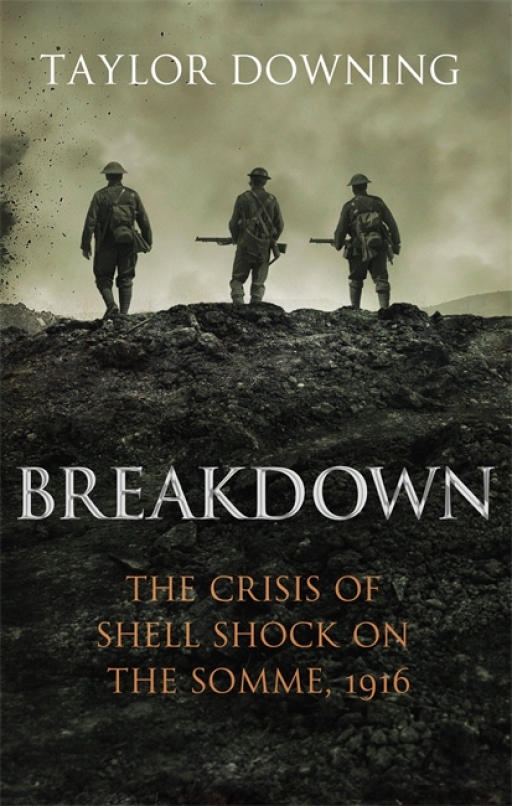Publisher’s Description:
‘By the beginning of August 1916, nearly 200,000 British soldiers had been killed or wounded during the first month of fighting along the Somme. Another 300,000 would be lost before the battle was over. But the army always said it could not calculate the exact number of those suffering from shell shock. Re-assessing the official casualty figures, Taylor Downing for the first time comes up with an accurate estimate of the total numbers who were taken out of action by psychological wounds. It is a shocking figure.
Taylor Downing’s revelatory new book follows units and individuals from signing up to the Pals Battalions of 1914, through to the horrors of their experiences on the Somme which led to the shell shock that, unrelated to weakness or cowardice, left the men unable to continue fighting. He shines a light on the official – and brutal – response to the epidemic, even against those officers and doctors who looked on it sympathetically. It was, they believed, a form of hysteria. It was contagious. And it had to be stopped.
Breakdown brings an entirely new perspective to bear on one of the iconic battles of the First World War.’
Centenary News Review:
Review by: Eleanor Baggley, Centenary News Books Editor
Writing in The Lancet in February 1915, Dr Charles Samuel Myers concluded that although some of the soldiers he had treated were not physically wounded, they were suffering from some form of physical concussion caused by the proximity of shell blasts. He described this condition as shell shock. This term, adopted from the soldiers’ own language, had an instant resonance. It seemed to perfectly describe the sobbing, cowering, immobile and mute men coming down from the front lines.
Shell shock was soon found to be a problematic term, not in the least because a large proportion of the soldiers labeled as shell-shocked had in fact been nowhere near an exploding shell in the moments before their ‘shock’ began to present itself. Though problematic the term lingered throughout the war, eventually being split into ‘Shell Shock (W)’, for those injured as a result of enemy action, and ‘Shell Shock (S)’, for men who had become unstable or hysterical in the trenches. Unsurprisingly the treatment and reception of the mental wounds of the men diagnosed ‘Shell Shock (S)’ was very different to their counterparts.
Breakdown focuses on the crisis of shell shock on the Somme, but much of the research goes beyond that, giving us a broader understanding of the epidemic whilst digging deeper into its effect on the Somme battles.
I was particularly grateful to Downing for putting shell shock firmly within the context of the First World War. Intertwined with his shell shock narrative is an exploration of the war, the rush for recruitment, the battle plans and the battles themselves. This ensures that we fully understand how and, to a certain extent, why, this mental trauma began in the first place and how it managed to affect so many soldiers.
Downing achieves this wonderful contextualising by focusing on the Pals Battalions from sign up to the Somme. The Lonsdales are at the centre of the narrative and we hear about the creation of the battalion in 1914, up to their near decimation on 1st July 1916. After their advance more than half the battalion were lost, including the Commanding Officer, the second in command, the adjutant and the majority of the commanders. Only 6 officers survived the push.
Nevertheless the remaining soldiers were sent back to the front line only days later after having endured the atmosphere of decomposing bodies and sorting through the belongings of their fallen pals. It is no wonder that 9 men were diagnosed ‘Shell Shock (W)’ the following day, nor is it impossible to believe their refusal to fight in the next push. This collective act of disobedience led to a whole series of events and encouraged further anxieties on behalf of the generals that shell shock was becoming contagious.
As in his previous book, Secret Warriors, in Breakdown Taylor Downing has approached a vast and complex subject deftly and with a particular focus on the details. Part of Downing’s power as a writer of military history comes from his interest in the people on the ground, not just in the politicians and generals.
I would argue that the strength of Breakdown lies in the story of the Lonsdales – Downing follows their journey from signing up in 1914 to the horrors of the Somme. This historical storytelling ensures that we do not forget for a moment that these soldiers were real men, not just names in a history book, who truly went to hell and barely made it back again, if at all.
Ultimately Breakdown is a fantastic addition to the study of the Somme and to the study of shell shock in general. Downing takes a different approach to the condition, exploring its role within military history rather than the psychology behind it. This new perspective complements the existing research perfectly. Breakdown is both meticulously researched and well written, making it a book to be enjoyed by historians and casual readers alike.
Eleanor Baggley has also spoken to Taylor Downing for Centenary News. Her interview can be found here.
What do you think about this book or review? Please add a comment below.
